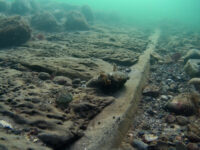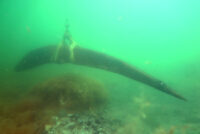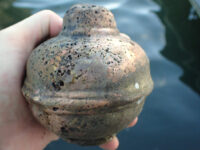 Marine archaeologists have discovered the wreck of the Delmenhorst, a Danish warship lost in the Battle of Fehmarn in 1644. It is the last of the ships from that battle to be found. It was discovered during an archaeological survey in advance of construction of the Fehmarn Belt underwater tunnel connecting Denmark and Germany. The wreck was in shallow waters — just 11 feet under the surface — 500 feet off the southern coast of Lolland near the town of Rødbyhavn.
Marine archaeologists have discovered the wreck of the Delmenhorst, a Danish warship lost in the Battle of Fehmarn in 1644. It is the last of the ships from that battle to be found. It was discovered during an archaeological survey in advance of construction of the Fehmarn Belt underwater tunnel connecting Denmark and Germany. The wreck was in shallow waters — just 11 feet under the surface — 500 feet off the southern coast of Lolland near the town of Rødbyhavn.
The Delmenhorst was deliberately grounded by Danish forces towards the end of the battle when it became clear that Sweden was winning. They wanted to use its heavy cannon to defend the harbour of Rødbyhavn, but the plan failed when the Swedes set fire to one of their ships and sailed it into the Delmenhorst. The Danish warship caught fire and sank.
The Battle of Fehmarn took place during the Torstenson War between Sweden and Denmark-Norway. The war began in December 1643 with a Swedish invasion of the Danish Duchy of Holstein and ended in the humiliating defeat of Denmark in August 1645. King Christian IV of Denmark lost an eye in the war and Denmark-Norway lost piles of revenue, territories and its domination of the Baltic Sea.
 The wreck was first spotted with side-scan sonar. Divers explored the wreckage and found a 20-foot section of keel, charred timbers, the bottom of the hull and ballast stones. Scattered debris around the remains of the ship included the melted, cracked and exploded remains of bronze cannon, evidence of the destructive powder of the Swedish fireships.
The wreck was first spotted with side-scan sonar. Divers explored the wreckage and found a 20-foot section of keel, charred timbers, the bottom of the hull and ballast stones. Scattered debris around the remains of the ship included the melted, cracked and exploded remains of bronze cannon, evidence of the destructive powder of the Swedish fireships.
A few objects and samples have been raised from the wreck site, but the  bulk of it will remain where it is. Because it is in such shallow water making it unhealthily accessible to tourists, the remains of the ship will be buried in sand for its own preservation. Archaeologists from the Viking Ship Museum have taken 30,000 photos of the wreck that will be used to create a digital 3D model that can be studied and exhibited at the museum without disturbing the site itself.
bulk of it will remain where it is. Because it is in such shallow water making it unhealthily accessible to tourists, the remains of the ship will be buried in sand for its own preservation. Archaeologists from the Viking Ship Museum have taken 30,000 photos of the wreck that will be used to create a digital 3D model that can be studied and exhibited at the museum without disturbing the site itself.